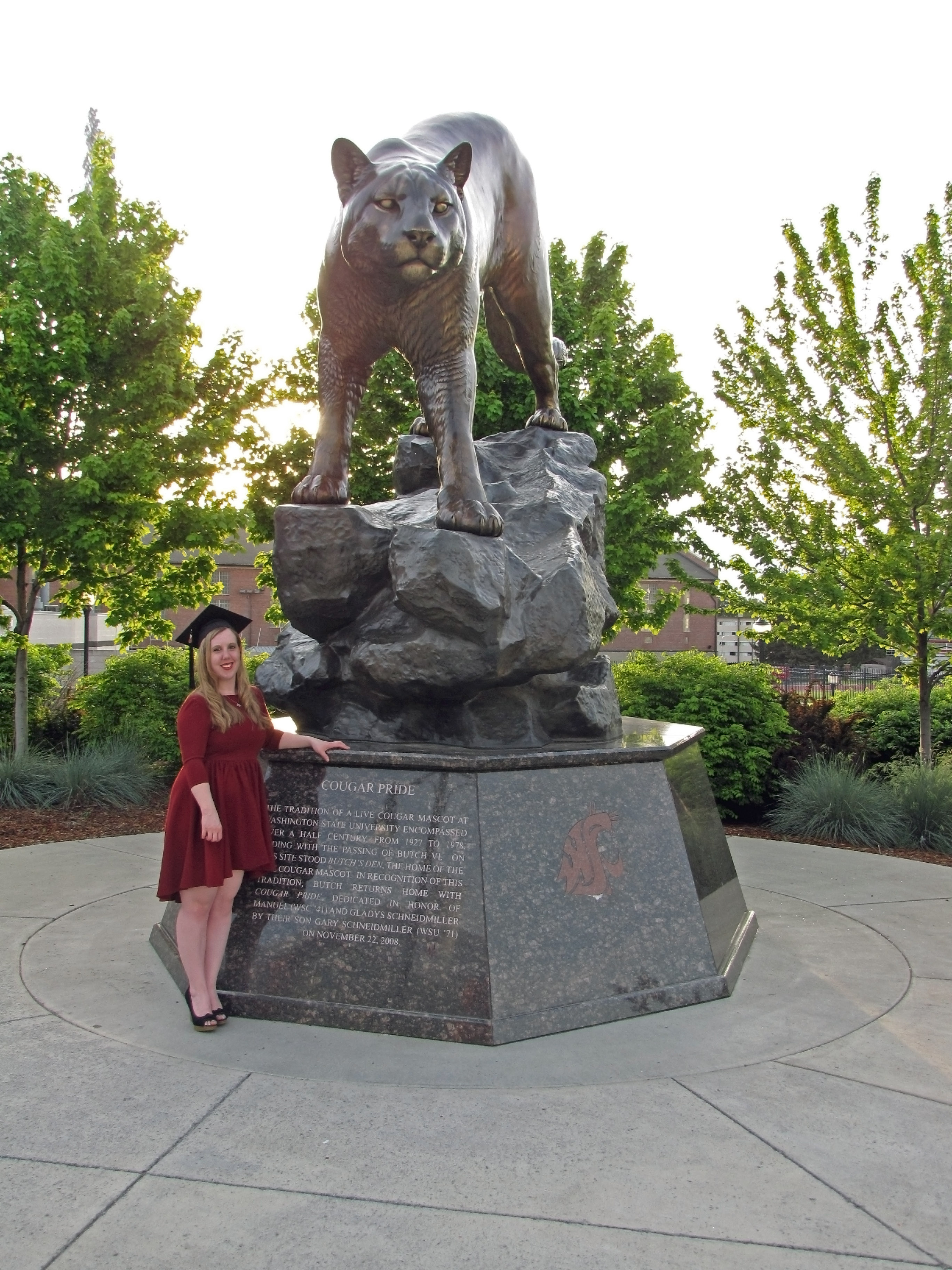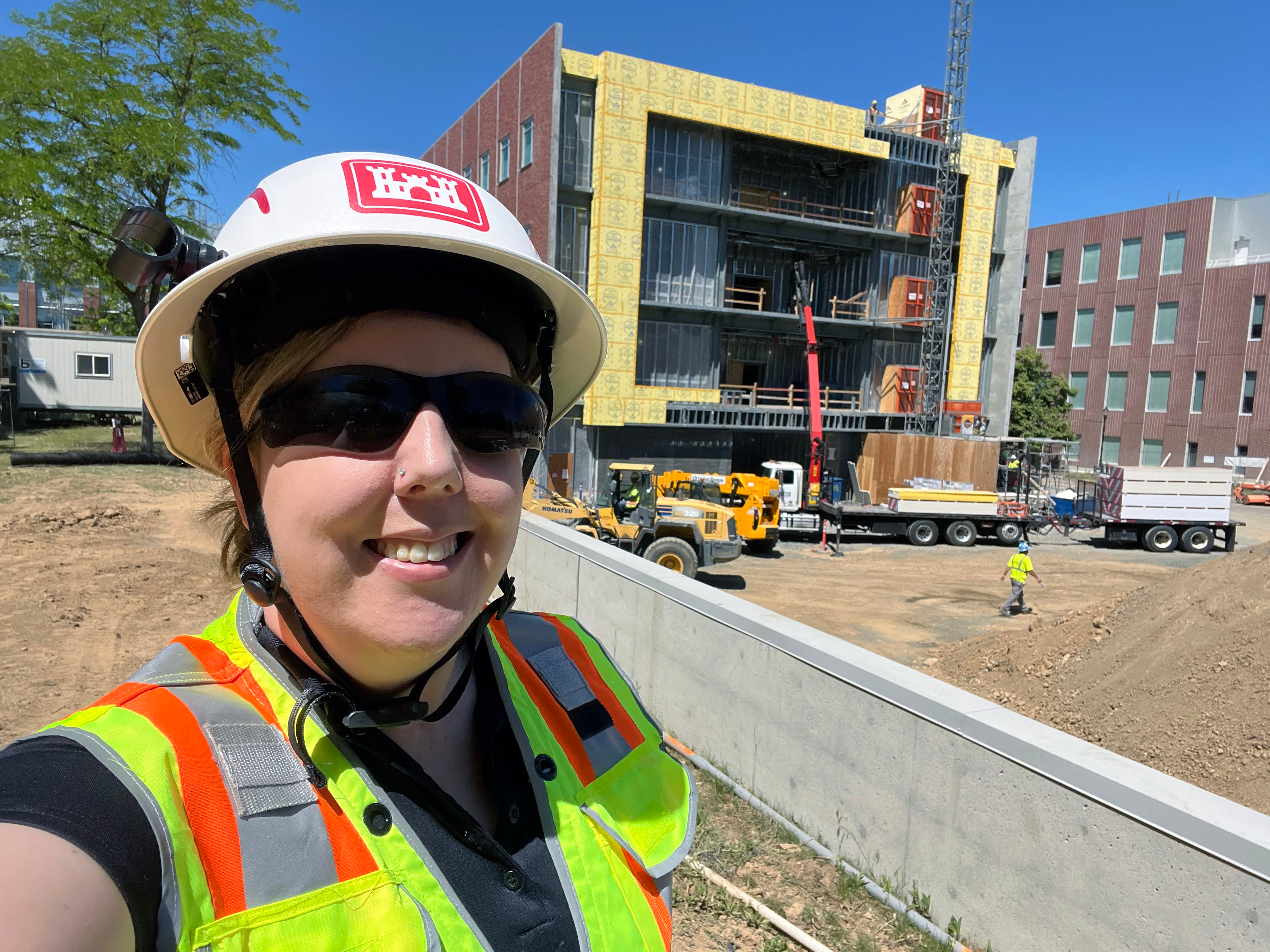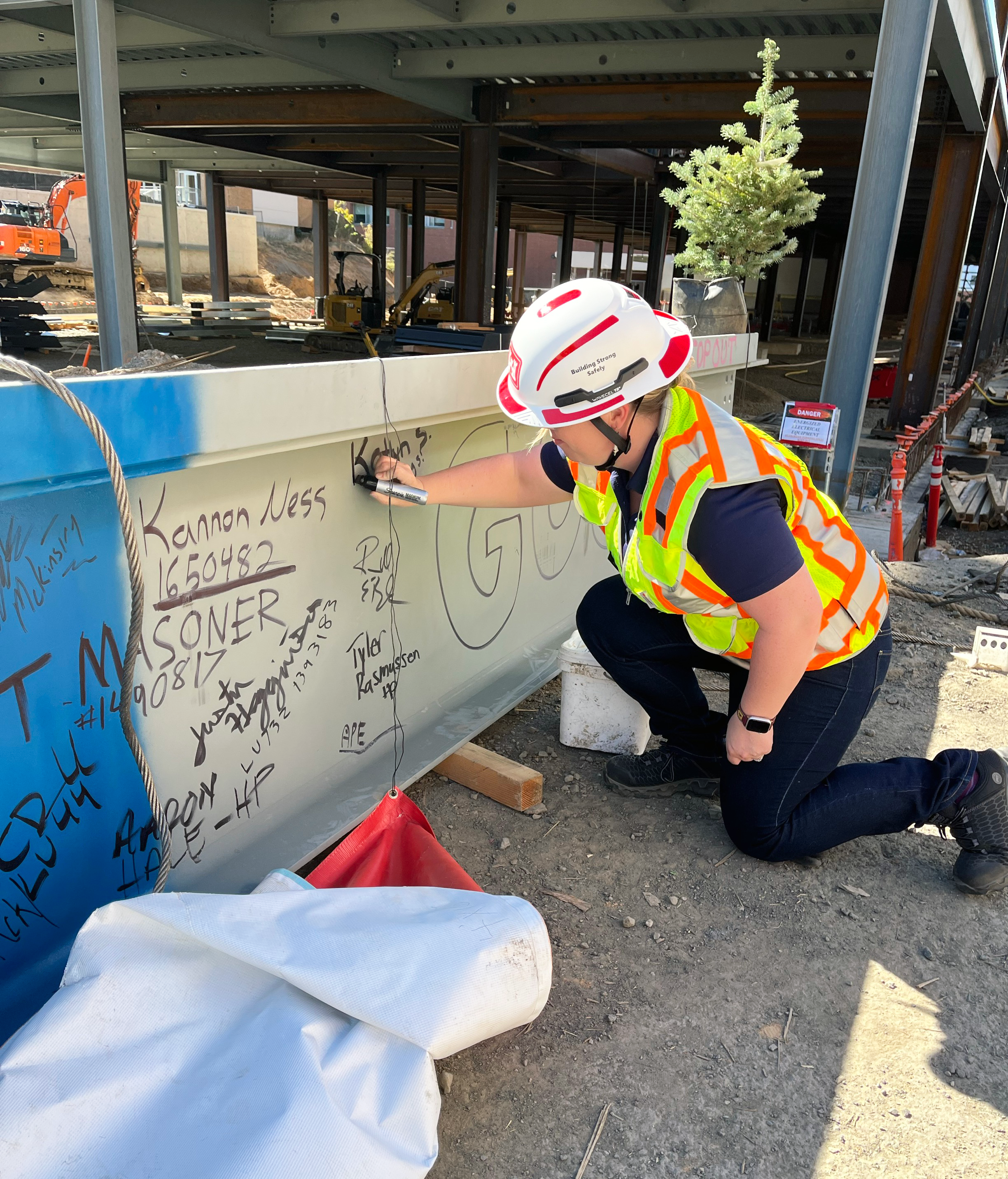For Katlyn Struxness, a project engineer with the U.S. Army Corps of Engineers (USACE) Seattle District, Pullman, Wash., isn’t just a place—it’s where innovation, community, and agriculture come together in unexpected ways.
It’s a town full of agricultural researchers breaking ground on world-changing projects, and for Struxness, it’s a place that’s become personal.
Her role in the USDA Agricultural Research Service (ARS) Plant Sciences Building project on Washington State University (WSU) has deepened her connection to the Palouse region, a place where she can be part of something larger than her job.
“I’ve fallen in love with the community here,” Struxness shared. “There’s something really special about Pullman. You can feel the energy from all the people invested in agriculture and innovation.”
The Washington native’s journey with the Seattle District—the USACE district completing the project on behalf of USDA ARS—has been a mix of logistics, excitement and a deep sense of purpose.
She’s not only overseeing the construction of a state-of-the-art building that will replace WSU’s legendary Johnson Hall, she’s also a key player in creating a facility that will support cutting-edge agricultural research for the Pacific Northwest and nation.
With over $100 million in federal funding backing the project, the new building will help house four ARS units alongside various WSU departments, including Plant Pathology, Crop and Soil Sciences, and Horticulture. The result will be a collaborative space for USDA ARS and WSU to tackle agricultural challenges.
The August 2023 groundbreaking was a momentous occasion for both WSU and USDA. Demolishing Johnson Hall, WSU’s largest-ever demolition project, marked the end of an era and the beginning of a new chapter in agricultural research on the Palouse.
The new building, with an estimated completion of spring 2026, will become a hub for the kind of groundbreaking work that has made WSU an agriculture leader while advancing WSU’s goal of being recognized as a top 25 public research university by 2030.
Her passion for the region and the project was there from the very start.
“Pullman isn’t just a college town to me; it’s a place where things that matter are happening. Agriculture is such a big part of this community, and being involved in this project makes me proud. It’s not just about building a structure. It’s about building a place where future solutions to global problems will take shape,” Struxness reflected.
A Washington kid stays home
Struxness grew up in Washington and wanted a college experience that felt close to home, but also offered a strong engineering program; WSU was the perfect fit.
“I think I just wanted something different,” she said. “I wanted to go to the other side of the state, and I really liked the idea of a true campus town—something that felt like a community.”
Her road back to Pullman and working as a USACE project engineer was anything but conventional.
“My best friend’s parents went to WSU, and they told me how good their engineering program was,” Struxness recalled. “I remember being really torn between chemical and mechanical engineering and needed to decide, ‘do I like gears and heavy machinery or chemical reactions more?’”
After browsing through the course catalog, she ultimately decided that a future full of valves, deconstruction and failure analysis was the right fit.
“I took a shot in the dark,” she said with a laugh. “But once I got into mechanical [engineering], I loved it. Labs like Experimental Design were the best. You’d go into the lab with something like a fan and figure out the air velocity and pressure, attributes of the performance curve. I love that kind of stuff.”
After graduation, Struxness began her career with the Puget Sound Naval Shipyard in Bremerton, Wash., after spotting a Navy booth at a career fair.
“I saw this recruiter and just walked up to him and started joking around casually, but one thing led to another and three weeks later, I had a job offer I couldn’t pass up.”
Her time with the Navy sent her all over: from the sun-filled skies of San Diego, California, to being around fighter jets aboard an aircraft carrier. Almost six years later, and after months of constant overtime, Struxness was ready to leave the shipyard for a change of scenery and pace. She moved to Pullman with her then boyfriend (now husband) and waited for the perfect fit.
Fortunately, a former colleague alerted her about an opportunity with USACE. “He said, ‘Hey, you live in Pullman, right? There is a project engineer job that you would be perfect for, and it’s going to be at WSU,’” Struxness recounted. “I was so excited.”
Struxness may not have known it at the time, but she was stepping into a role with one of the country’s oldest and most trusted engineering organizations. For 250 years, USACE has been the go-to team for solving big, complex problems—from protecting communities from floods to keeping the economy moving with infrastructure and navigation projects. The mission has shifted with the times, but one thing’s stayed the same: USACE builds things that matter, and now she was a part of it.
The project engineer’s view
Struxness plays an integral role in the ARS/WSU Plant Sciences Building project. Behind the scenes, she keeps construction on schedule, aligns milestones, and ensures clear coordination among all stakeholders—from ARS and WSU to contractors and consultants."
But that doesn’t mean she isn’t on the job site either; it’s her favorite spot.
“There’s something satisfying about watching a building take shape right in front of you—especially one that’s going to do so much good,” explained Struxness. “It’s something you and rest of the public can see, so it feels like a celebratory moment. Like, ‘Yes! It’s really coming together.’”
But it’s her communication skills that really stand out. She ensures that everyone involved, from researchers to construction crews, stays in the loop, creating a seamless process where information flows freely and everyone can move forward with clarity.
“We need to make sure that all parties involved, whether it’s a research scientist or a contractor, understand the larger vision,” Struxness explained. “That way, we can keep the project moving smoothly and efficiently.”
Strong communication also helps Struxness also act as the eyes and ears for all USACE activities on the ground.
“Katlyn is the crucial link for all the meaningful integration with USACE and federal agencies, the university, and the contractors,” explained Maj. Matthew Krause, Seattle District project manager. “She is where the rubber meets the road, and her role has been indispensable for our ability to maintain the scope, schedule and budget of this massive project.”
As construction continues, there’s focus on the bigger picture—that this is more than building walls and pouring concrete. It’s about the future of agricultural research.
The ARS Plant Sciences Building will feature modern laboratories and open collaborative spaces designed to foster creative problem-solving among researchers. The goal: advance agricultural practices that will help feed a growing global population while making farming more sustainable and efficient. This is where innovation will happen, where scientists will explore ways to improve crop yields, fight plant diseases, and enhance environmental sustainability.
Her work contributes to that broader vision. “I’m excited to see this project come to life because it’s not just a building—it’s a place where the next generation of agricultural breakthroughs will happen,” Struxness shared. “We’re building a space that will directly impact how food is grown, harvested, and distributed. It feels like we’re laying the groundwork for the future.”
A toast to Johnson Hall
Once a key space for WSU’s research—Johnson Hall’s demolition was a bittersweet moment for many on campus. To preserve and share the decades of history, WSU created a digital scrapbook for researchers, students and alum to share their favorite memories.
WSU class of '77 alumnus, Russ Salvadalena, used the opportunity to share a story of unique creation in the building’s fruit and vegetable processing area. “As a food science major, I took a class in Johnson Hall that used that area to teach about processing equipment. I recall one lab where we developed a new potato product. It tasted good but the texture was kind of gooey. We named the new product ‘Tater Snots.’”
It's a necessary step toward progress. The building, which stood for decades, was no longer equipped to support the evolving needs of researchers and students. The new building will ultimately serve as a modern home for WSU’s agricultural science.
“Change is hard, but necessary,” she acknowledged. “That old building served its purpose, but as research and technology evolve, so do the facilities that house them. We need a space that reflects where we’re headed. And that’s what we’re creating here.”
Home is where you make it
Struxness’ connection to Pullman is deeply personal. She jokes that you either love Pullman or you hate it. Its charm, tight-knit community and strong ties to agriculture and research gives her a sense of pride in what’s being built.
 “Working on this project is really meaningful to me because it’s about more than just construction,” Struxness explained. “It’s about creating a space that will help address some of the biggest challenges we face, like food security, environmental stressors and sustainability. I can honestly say that I’m doing work I’m proud of.”
“Working on this project is really meaningful to me because it’s about more than just construction,” Struxness explained. “It’s about creating a space that will help address some of the biggest challenges we face, like food security, environmental stressors and sustainability. I can honestly say that I’m doing work I’m proud of.”
There are reminders every day of the legacy she’s helping to create—one that will not only serve today’s agricultural researchers, but also the students who will one day walk through the halls of the new building, carrying the torch for the next wave of innovation.
“It’s exciting to think about how this space will be used in the future,” Struxness reflected. “There will be future agricultural scientists and engineers working in this building, tackling problems that we can’t even foresee yet. To be a part of that, even in this small way, is incredibly rewarding.”
Until then, construction continues, and a final exterior and interior design elements will be complete by summer’s end. USACE Seattle District’s project delivery team will focus on completing the building’s exterior, establishing connections to Vogel Hall and the nearly finished pedestrian bridge to Plant Sciences Building (Rec 5) in addition to extensive mechanical, electrical, plumbing, and fireproofing work throughout the floors.
She knows the project will leave a lasting mark on agricultural research in the Pacific Northwest when it’s finished.
For Struxness, the work isn’t just about building structures—it’s about leaving a mark on her college town. “You either love or hate Pullman…and I happen to love it.”